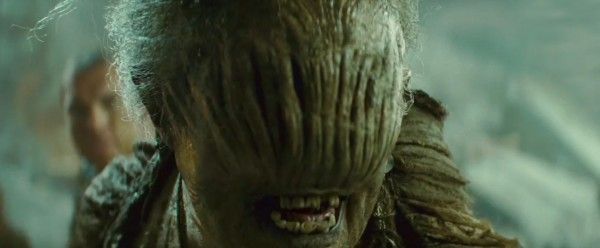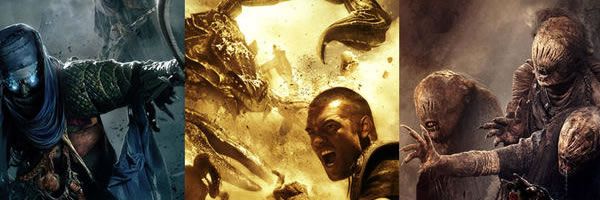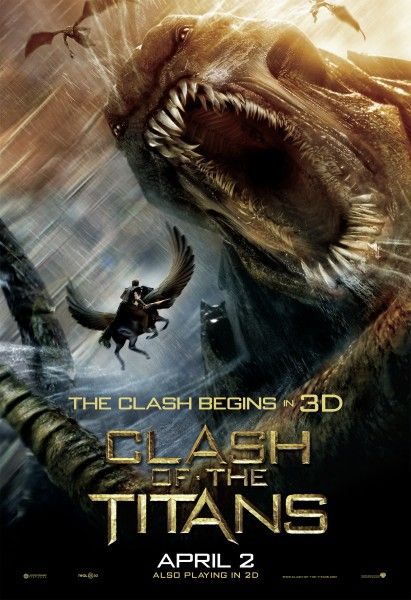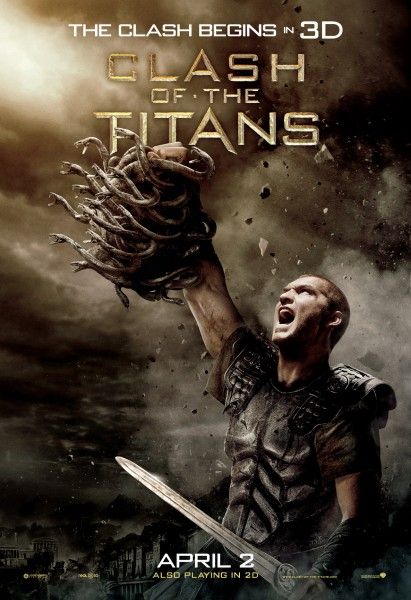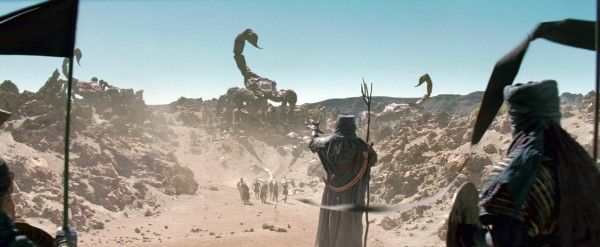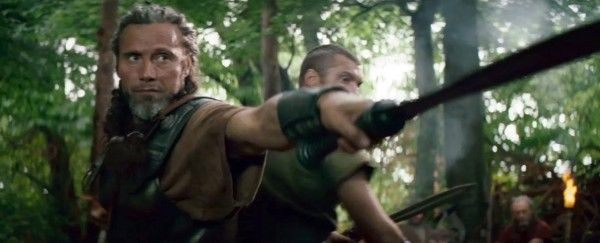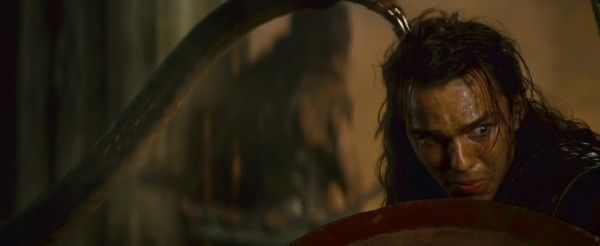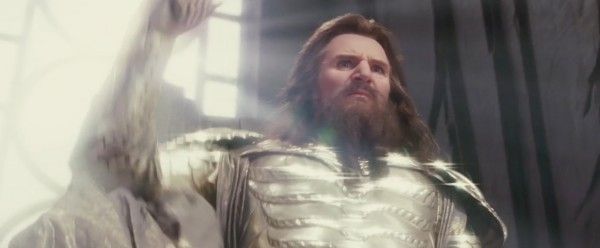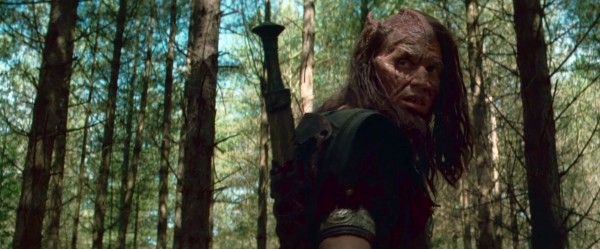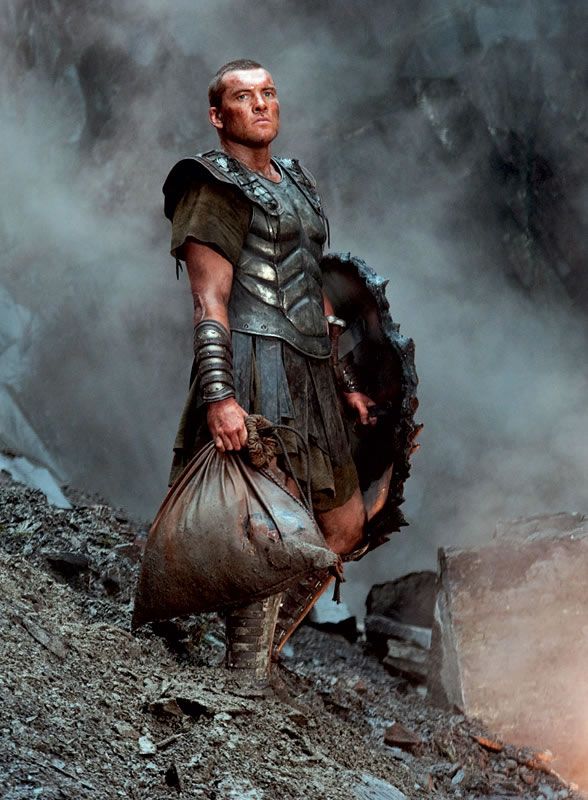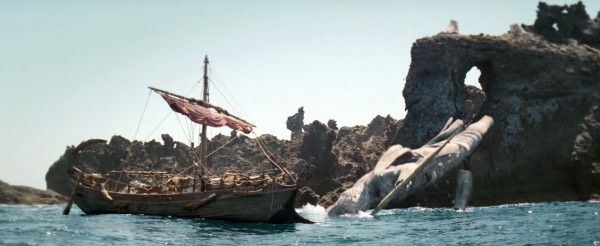If you look over producer Kevin De La Noy's resume on IMDb, it's kind of awesome. The reason is he's worked on movies such as The Princess Bride, The Dark Knight, Braveheart, The Fifth Element, even Saving Private Ryan. While his job titles have ranged from location manager, production runner, producer, and assistant director, he's still been involved in some of the biggest movies over the last two decades.
Anyway, when I got to visit the set of Clash of the Titans outside of London last August, I was able to participate in a roundtable interview with De La Noy. During our extended interview he talked to us about why they wanted to remake Clash, the use of CGI versus practical effects, how they were filming around the world, and he explained the secrets of making a big movie come together. If you've ever wanted to work on a big Hollywood movie, you should start by reading or listening to what Kevin De La Noy's had to say about Clash of the Titans. Hit the jump to check it out:
As always, you can either read the transcript below, or listen to the audio by clicking here.
If you haven't seen the teaser trailer for Clash of the Titans, I suggest watching this before reading the interview. It's kind of awesome.
-
Here's the synopsis:
In Clash of the Titans, the ultimate struggle for power pits men against kings and kings against gods. But the war between the gods themselves could destroy the world. Born of a god but raised as a man, Perseus (Sam Worthington) is helpless to save his family from Hades (Ralph Fiennes), vengeful god of the underworld. With nothing left to lose, Perseus volunteers to lead a dangerous mission to defeat Hades before he can seize power from Zeus (Liam Neeson) and unleash hell on earth. Leading a daring band of warriors, Perseus sets off on a perilous journey deep into forbidden worlds. Battling unholy demons and fearsome beasts, he will only survive if he can accept his power as a god, defy his fate and create his own destiny.
-
Question: Why did you think now was a good time to remake "Clash of the Titans" and what was the concept behind the remake?
Kevin De La Noy: It was timely, and we got the technology, you know? (Ray) Harryhausen's work was all that was seen at the time; that was it. That was as good as claymation gets, then there was the movie into models and then into digital. The original "Clash of the Titans," which was strands of Greek mythology woven together by Beverley Cross for that movie, pulled together so many forces that it was deemed a property right for a remake. If there ever was what makes a remake and why would you do something again? Is it a different cast? Is it a different director or a different angle on it? Well, clearly with our mythological creatures, the realm of digital FX is clearly going to give it a different look and the intellectual property rights sat with Warner Brothers and Basil, the other producer on the show, had it for sometime and it had gone through a couple of incarnations. Then the studio saw Louis' work on the Hulk, he came together, and as well you know, a movie is like a snowball, it needs some momentum and it needs a push, and it needs many things to happen, the confluence of why a movie happens. I'm sure people have written many a thesis on. Louie and I came on board at the same time, used to putting together movies in difficult places with international logistics, that sort of thing. Then Sam came onboard and at this point, our timing was disastrous simply in, we were trying to up the budget of a movie while there was a world recession going on. That's not good, but we're here, so we succeeded.
You mentioned the property rights, so why is it important to do "Clash of the Titans" rather than a Greek mythology movie?
De La Noy: It's not (laughter)... to be honest. There are property rights to Greek mythology but "Clash of the Titans" was a treatment of mythology that brought together all these different characters and that as a structure is appealing. You're starting from something there. With a remake you're buying that skeleton, but the flesh of that skeleton like all of us is completely different.
Would it be fair to say that the original Clash of the Titans, while well loved, is still a film that you look at it and go, "That could do with a little bit of polish"?
De La Noy: Yeah, in it's time that was a quality. I think you do look at these things and there is the phrase, "a contemporary take on something." Like gangster movies. It is a film that does have the ability to go back into its own history and do a different take on it and that take is for the generation. There are our timeless movies and there are the movies that as a child we thought were the coolest things ever and upon revisiting, you go, "Oh really? I thought that was cool," and same with our wardrobes.
Looking at the sizzle reel, there are a lot of great outdoor locations so was "The Odyssey" a big influence?
De La Noy: No, although a lot of that lurked in the background. What you saw in that sizzle reel, first of all was something that hooked me into the project, was there was a fundamental decision made very early on that we were not going to go down the route of green screen and composite digital landscapes. Our 200 B.C. mythological world, you could snort it, you could put your foot in it. It had to be real, and, for me, that was an attraction because internationally, that's what I like to do: accessing locations, setting up countries and things that the audience hasn't been to before, as best one can. So we made a decision not to go, as it is known because it was so successful, "the 300 route." We didn't go the route of, "We'll create this fantastic world and we'll do the green screens." Now, we use the expression "the 300 route" because their's was the finest rendition of that particular way of making a film and deservedly so. We wanted to go forth into the real world, and I used to work as a location manager and work with some of the finest designers in the world and directors who shoot locations extremely well. I set-up movies. like "Saving Private Ryan" with the beach invasion, and "The Last Samurai," those sorts of things. So, I wear boots still, so that was something I wanted to do and that was something Louie wanted to do. What you saw in that sizzle reel, you saw locations predominately from the Canary Islands because it was the first 6 weeks of photography. What you did not see is the stuff we did in Wales and the great slate mines and quarries and underground tunnels going into the core of those mountains. In 3 weeks, 4 weeks time, I'm off to Ethiopia to the Danakil Depression, which is a warzone near the Sudan--National Geographic had filmed there once or twice, and we're taking "Clash of the Titans" into that area. Bright yellow, sulfur-filled lakes and active volcanoes, to give this film, not only grit, but also epic. It's anamorphic, the big landscapes are very important. The world in which they are going and inhabiting should take your breath away.
I wanted to ask about the timing because this movie is already scheduled to come out in March, and there are many movies coming out next summer that finished shooting months ago, and I was curious about the timing of still shooting this close to release.
De La Noy: Well, you're curious... I'm panicked. You're absolutely right. It was a target we were set, and it was a precondition to doing the movie, so it's been very tough on Louie. It's been tough on all departments. We're in production and we're in post-production parallel, which presses huge pressures on everyone. We're fighting to get time to workout how we're doing things, to test rigs, to do all the stuff you need to do to make a movie, and the director on the weekend is not only editing the movie, but he's also deciding where our Medusa will be in a frame and houses are having to commit. Normally, that post-production period would not only be much longer but it would be somewhat discreet from the process of shooting the movie. we're doing production and post-production contemporaneously and have been since, believe it or not, the end of May.
You talked about updating it for a modern audience, what does that mean exactly? More action, more creatures?
De La Noy: If you go back and look at any of these older movies, there's a sense of the actors are carrying the social structure of the time the movie was shot. And every now and again, if you can overdo it, you can see movies that break that mold. Well, they did, as you said, with the Burgess Meredith stuff and those single shots of "By the Gods!" Those worked then, because in that period that was acceptable, and that was an acceptable force to drive a narrative in the '80s than it is now. So, actors inhabit a more contemporary version of it, although against a mythological background.
In terms of what works in a movie, apart from acting style, does it have to be bigger? Does it have to have more special effects? Does it need more action? Was that the mandate going in?
De La Noy: No mandate. No mandate. The director's take on the project, which is considered important and Warners is a great studio for directors to take and realize their visions, it's a good environment.
When I was a young lad, we watched "Clash of the Titans" over and over, it was one of our absolute favorites, and we talked about different set pieces. We love the part where the statue head would talk and I wondered how it felt to recreate certain segments from the movie and how you decided whether you needed to do that or not?
De La Noy: It wasn't a comparative sheet. We took the main thrust of the story and took certain... for instance, the scorpions in the original are minor. In ours, we develop that form a lot more. So we didn't do it, "Oh we like this so we'll make that big," we went , "Okay, we know all the characters, then we'll take the story and let that develop." There was no inter-textual comparison going on. There will be moments in this movie that will be more outstanding than in that. Let that have its life. We've taken a lot of the characters and developed them. Clearly, lines like "kill the kraken" are all very important lines and those characters are there. We have characters such as the harpies that are ours, we've put those in, and the scorpiochs, our take on the scorpions, are a much stronger feature. The two will stand autonomously although there will be parallels.
One of the things about the original is that it's just the one movie and while the correct answer is "We'll make the movie and see how it does" but have you thought more about how you can create a franchise in this mythological world?
De La Noy: Yes. Quite simply, yes. If the audience, the storytelling, the whole thing works, then clearly there are survivors and there are deaths in this movie, but the whole world and mythology is there to be explored. What will be interesting is the reception of our treatment of mythology with a slightly distinctive look. I mean, you look at the armor, you look at the costumes, you can see that it is based upon history, but you can also see there is a slight twist to it. It's not overt, but there's a slight twist there. If that all comes together it's going to meld into a movie that, without a doubt, there are other avenues in mythology that we could go to. Perseus did through the mythological world go on several journeys and without a doubt there is a strong potential there.
One of the things about the original was that the stop-motion animation looked cheesy and dated, but it added a charm, so did you try to keep some of that feel?
De La Noy: The two don't mix. That stop-motion worked, because that was the way of putting over the mythological creatures and things. We've replaced stop-motion by visual FX.
At the same time, Jason Flemyng's look as Caliban is more practical using make-up FX, and you have an animatronic Medusa head, so how important is it to use practical in-camera FX whenever possible rather than CGI?
De La Noy: For us as a group of filmmakers, it's hugely important. Our visual FX supervisor Nick Davis, the last thing he and I did together was "The Dark Knight," and yet again, on that movie we did as much as we could in-camera, so there was kind of a seamless blend. Obviously, we can't make a Kraken. There are certain things that have to be within the realm of the digital, but where we can, we use practical effects. Our practical effects supervisor Neil Colbolt, who did "Black Hawk Down," and he and I did "Blood Diamond" together. He's a solid special effects operator. In addressing how we were going to do a piece of an action or an effect, it's very much, "We can go both ways here, which way do we go?" We've gone for what would be visually most effective. The things we knew would have to be digital, we've done digitally, but at the same time, various component parts of them, we did for real so the blend through to the audience isn't just obvious.
How are you representing Olympus, the home of the Gods?
De La Noy: With a twist.
Is it a physically place we could get to?
De La Noy: They're in the heavens.
So technologically, I can understand why this was the time to do this, was there anything narratively that you think makes this a contemporary spin on the tale?
De La Noy: Yeah, without a doubt. I think that was one of the driving forces again for the studio saying, "Okay, we can see this as a good thing." Perseus is a demigod, he's struggling with both being a human and being a god. All kids grow up struggling with that, not godliness, but that whole question of "Who am I?" It's a question we've all asked ourselves and where we sit in it. Also, the movie has a strong sense of destiny and fate, which has long intrigued the human race whether we are destined to do something or not. It also follows him through, it starts as in the original, of him starting out, like in the original, as a baby and becoming a man so there is a life journey. So you've got the life journey, you've got destiny and fate, you've got the whole thing of gods influencing life as well. They are all strands that play here. You put that into a contemporary groove against this backdrop and you've got something quite interesting there.
Circa 2009, 2010 what is the psychology of that time?
De La Noy: If you could explain to me what the psychology of 2009, 2010 is I could answer the question.
Greek mythology is about telling the story of the time, so my question is, is there something 2009, 2010 in the story you are telling.
De La Noy: Good question. My argument to that would be mythology and saga has a life because it deals with humanist traits and humanist questions to history. There is no moment in this film that locks it into 9/11 or a world economic crash. This is a work that has a PG-13. We have to, within it, good and bad has a white hat black hat thing going on. They aren't going to pick up a cut or a thrust within it. The joy is within the exposition not in the initial education.
What is the X-Factor?
De La Noy: He has got a handle on, he sees a scene and executes the scene. The camera is probing and finding, it is not a static camera. It is very dynamic. I think you saw from that sizzle reel the shots were always moving and developing. I think what he's bringing to the film is a great pace. We know the characters but the way he lets them unfold and the pace and energy of it. This is not a passive film, it has a beat. It benefits from the scoring and the sound effects, what noise does a Medusa make? It will be more complex then just a rattle snake over. We have a whole world with creatures with noises coming in which will help boost this. I think that's what he will bring to it.
What's great about the original is the creatures aren't just a throwaway thing they are characters in their own right.
De La Noy: They are not just going to be an effect, there is interplay between them as well. We've done some great stuff with the Medusa specifically in relation to that.
Will there be both minotaur's and centaurs in this movie?
De La Noy: We have to leave some things out.
You haven't done the edit yet, but do you know how much exposition you'll leave in or is it going to be all action?
De La Noy: One's a counterpoint to each other, so there will clearly be both. The balance of the movie is you swing the emphasis and we have considerable latitude there.
In the original film you can see they are having fun, what is the tone in this? There is a lot of fun in the original is this going to be grim and gritty?
De La Noy: There is fun as well. This is not an R-Rated Clash of the Titans, there would be no value to that. So the fun element is there.
You said that the film would be PG-13 and very Black and White, the thing about the god's themselves is they are very Gray as Zeus raped the Queen to conceive Perseus. How is that going to be handled?
De La Noy: When I said it Black and White I meant that you know going in that there is black and white, I'm not saying this film is black and white. The thing about storytelling of this level where you have to appeal to children who do not know what Clash of the Titans is and generations who consumed the previous Clash of the Titans and generations who are familiar with mythology through classical education. That's a pretty broad spectrum audience, and so with the mythology and the way we are handling it some are the darker stories, the rape of Dani becoming the Medusa, it's there but it's not a history lesson do you see what I mean. It's not explicit because I think once you start going down those roads it's a lot of screen time telling something. You have a 13 year old it's going to raise a lot of questions and they are going to get lost in that. We are striking a balance between all of this.
I have this image of everyone in pre-production going through a textbook and highlighting their favorite bit (laughter). I mean, was there a learning curve?
De La Noy: A lot of that happened when we were prepping the film in L.A with the writers as to which bits. One of the great problems is sometimes less is more. There are so many good points, you're in a well stocked kitchen. We have to be careful not to over-egg our cake. You research one character and you come across another one, and you're thinking "well, how about that?" Diligence was done early on. We have to keep it into a size, because you're right, there's just so many characters that you could put in there.
What is the most shooting you've done on a sequence. What is the biggest action scene?
De La Noy: This end sequence, the set you'll see here, has an awful lot of time spent on it, but a lot of it will be in post production because it involves a Kraken. If you're just referring to shooting time?
I guess both.
De La Noy: Probably the end sequence will be the most time spent in the visual effects world and the battle we have with our scorpions took a long time because we chose a location that was just over 9,000 ft up a volcano in Tiena Reef, our hotel was a beat front hotel, so every morning 300 men - the crew - got into minibuses through the pines, then into the base of the clouds, and then we came out on top of the clouds and drove into this national park and we parked and traveled into our desert location which was pretty spectacular. You could see in the trailer coming up the clouds, we were above the cloud ceiling. Most people talk about the cloud base we drove through that. We shot our movie in thin air because at that point people were having altitude sickness, and then at the end of the day back down we came. So we were losing 3hrs a day getting our asses from point A to point B. Everything had to come up, your milk, your eggs, your bacon, your butter so that was a good 2-3 weeks run to get that sequence.
The film is obviously a very large budget, you have to make sacrifices and considerations of where you want to spend your money. In preproduction did you allocate where you want to spend your cash?
De La Noy: Yeah for me that is preproduction. I get a script and sit with the director and get a handle on his vision and then you have to see what he's passionate about. You look at the look at the film and where the director wants to go, and that has a price tag. That's why I spend a lot of time with my crew, 4 or 5 of us, melding this thing, saying that may have to go. That is the balance of the film. In early preproduction what makes a good movie is the focus there: making decisions and sticking to them has always been the big issues like Braveheart, where we said we're going to do this, it's going to be down, it's going to be dirty, and where's the base camp? Well it's going to be 3 miles that way. So Mel says well what are you going to do with the actors? And I say well if you don't have a trailer here they won't need a trailer here. He said you're right and so that decision really early on set the tone for the movie. Those formative months before the movie is greenlit is really are the base rock of your pyramid, and all of this stops it from falling over and gives it shape and gives it form, are those decisions. We made those key ones before we started our official preproduction. One of the things we wanted to do is not give another slice of Morocco where most of the times you go and there's the gaffer tape from the previous unit. We wanted to give something new so that our story had a degree of similarity. Our story was in a new world, our story was showing things that were new as much as one can. We wanted to do stuff that's new and stuff that will be visually spectacular.
You mentioned "300," same studio, same month of release, so how are you going to differentiate this to people?
De La Noy: Well the market obviously. I love this thing with dates. That was a pan-hole date until 300 came out. It made money and now it's the 300 date. The two things are not inherently linked if you've studied any form of economics. And I think that's the answer to the question, it's nonsense. The film will stand on its own two feet as one thing as it did. Our marketing, the word you guys put out, the feel for it, our teasers, our trailers; with all of that, it will have a life independent of.
Q: I don't know how the original movie played...but I know some movies play better in the States and some play better internationally or Europe. It seems like this could play in both places.
De La Noy: I think in the curriculum of education Greek mythology is not as dominant as it is in European education. So clearly there's an international swore here, but, at the same time, a lot of the traits in mythology are humanists and mythology: dragons, medusas, is cool shit no matter what you're culture. I think a film like this will work at different levels in different markets and I think because it's not solely segmental then it's international appeal will be quite wide. But I think it'll be cool stuff in the domestic market as well.
When I was younger I was into mythology but I'm not sure about kids today.
De La Noy: Yeah but I think they said the same thing about magic and Harry Potter came along. Pirates until Johnny did his skit. I think a story well told stands up and I think one of the important things for me doing the movies that I've done, I love movies that didn't follow. That made fresh tracks. Movies that were hard to get off the ground. Movies that you have to kick some butt and took risks on. For me the rebellious directors who had a great vision and said fuck it I'm going to do it those movies are great because it's very easy to mass produce mediocrity. It's very difficult to be bold and do something new.
Sam could not be any different than Harry Hamlin. So what is the difference between this Perseus and the one we know from the 80's?
De La Noy: I think we briefly touched on this. He's more contemporary, he's more savvy. The Harry Hamlin character kind of worked because we got Warren Beatty with his helmet hair and that worked, but that doesn't work anymore. That only works if you're Owen Wilson because it's gone from the realm of profundity to comedy. So we got this character inhabited as much more visceral and as much more practical. He suffers injury.
Would you say this is a angrier Perseus?
De La Noy: That's one facet of the way it's being played, yeah. Because it's a remake of Clash of the Titans one of the decisions we made was that we were going to give you guy's greater access than a lot of movies. I've never done as much access with my own designer at work because this is a film where we don't straight comparison. That's not what we set out to do. Our's is going to be a fresher look at it. And I think the way he's playing it is a fresher look.
In the original Perseus goes on this adventure with all these guys and I don't know who any of these guys are, in this one I see characters. Is that a big thing here? That this group that he's with are characters?
De La Noy: Yeah cannon fodder doesn't work with us. They're all characters with traits, with contributions to make, with their own curious habits. So when Perseus goes off on the journey the interplay of the personalities is core to that journey.
-
For more Clash of the Titans coverage, check out these links:
Sam Worthington On Set Interview
Gemma Arterton On Set Interview
Mads Mikkelsen On Set Interview
Director Louis Leterrier On Set Interview

